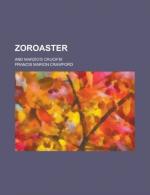He dwelt in Ecbatana of the north, in the tower he had built for himself.[1] In the midst of the royal palaces of the stronghold he had laid the foundations duly to the north and south, and story upon story had risen, row upon row of columns, balcony upon balcony of black marble, sculptured richly from basement to turret, and so smooth and hard, that its polished corners and sides and ornaments glittered like black diamonds in the hot sun of the noonday, and cast back the moonbeams at night in a darkly brilliant reflection.
[Footnote 1: Josephus,
Antiquities of the Jews, book x. chap.
xi. 7.]
Far down below, in the gorgeous dwellings that filled the interior of the fortress, dwelt the kinsfolk of the aged prophet, and the families of the two Levites who had remained with Daniel and had chosen to follow him to his new home in Media rather than to return to Jerusalem under Zerubbabel, when Cyrus issued the writ for the rebuilding of the temple. There lived also in the palace Zoroaster, the Persian prince, being now in the thirty-first year of his age, and captain of the city and of the stronghold. And there, too, surrounded by her handmaidens and slaves, in a wing of the palace apart from the rest, and more beautiful for its gardens and marvellous adornment, lived Nehushta, the last of the descendants of Jehoiakim the king remaining in Media; she was the fairest of all the women in Media, of royal blood and of more than royal beauty.
She was born in that year when Babylon was overthrown, and Daniel had brought her with him to Shushan when he had quitted Assyria, and thence to Ecbatana. In the care of the prophet’s kinswomen the little maid had thriven and grown fair in the stranger’s land. Her soft child’s eyes had lost their wondering look and had turned very proud and dark, and the long black lashes that fringed the heavy lids drooped to her cheek when she looked down. Her features were noble and almost straight in outline, but in the slight bend, at the beginning of the nose, in the wide curved nostrils, the strong full lips, and in the pale olive skin, where the blood ebbed and flowed so generously, the signs of the Jewish race were all present and unmistakable.




